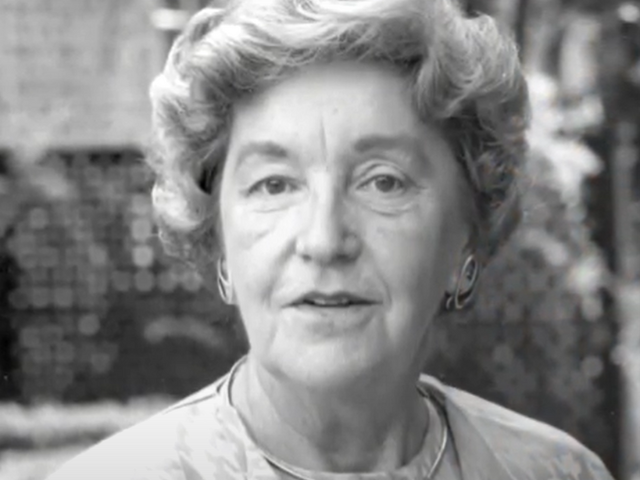
Frances Ravenel Smythe Edmunds. Image still from SCETV video.
(1916-2010) Edmunds was born in Charleston, South Carolina, the daughter of Augustine Thomas Smythe and Harriott Ravenel Buist Smythe. She attended St. Timothy’s School in Maryland and graduated from the College of Charleston. In 1943 she married S. Henry Edmunds, a Charleston lawyer and district attorney. They had three daughters.
Edmunds was a leading figure in the twentieth-century preservation movement in the United States. Through her leadership as director of the Historic Charleston Foundation, Charleston became a national preservation model. One of her earliest accomplishments was the revitalization of Ansonborough, a once-elegant neighborhood that was in a blighted condition by the 1950s. In 1957 she helped initiate the foundation’s revolving fund to purchase historic properties, sell them with protective covenants, and then reinvest the money into neighboring properties. This approach added a new dimension to preservation and was a departure from the traditional focus on individual landmarks. The foundation’s success using its revolving fund to save Ansonborough brought great visibility to Charleston’s preservation efforts and was adopted by cities across the nation. The foundation’s innovative preservation techniques were showcased in a government report, which later led to passage of the National Historic Preservation Act in 1966.
In the 1970s the foundation launched a new program to renovate neighborhoods without displacing residents. Edmunds worked to ensure that deteriorated historic neighborhoods were not taken over by absentee landlords. Edmunds also helped initiate a major revision to Charleston’s 1931 ordinance, started expansion of the city’s Historic District, and led the effort to preserve Broad Street as the city’s legal center. Edmunds recognized the importance of keeping historic buildings occupied, even if a change in use was required. She promoted height and tourism ordinances and stressed that Charleston was a living city, not a museum village. In 1977 she worked with the mayor and others to bring the Spoleto Festival to Charleston and ensured that the foundation played a major role in the purchase and stabilization of Drayton Hall. She controversially supported the trimmed-down Charleston Place development, which she believed would be the spark to revitalize King Street.
Edmunds received national recognition for her devotion to Charleston’s restoration and revitalization and for her contributions to the preservation movement. In 1971 she received the Louise E. du Pont Crowninshield Award, the highest national preservation award. In 1979 President Carter appointed her to the Advisory Council on Historic Preservation, and she received the Department of Interior’s Conservation Service Award. She was the first woman to serve as a trustee of Monticello and was an at-large member of the Garden Club of America. She also received numerous local and regional awards including an honorary doctorate from the College of Charleston in 1972. In addition she served on the board of the Spoleto Festival, on the Advisory Board of the Confederate Home and College, and on the city’s Board of Architectural Review.
She retired from the Historic Charleston Foundation in 1985, after thirty-eight years of service.


